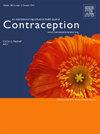流产限制与子宫切开术对早产的影响
IF 2.3
2区 医学
Q1 OBSTETRICS & GYNECOLOGY
引用次数: 0
摘要
目的:我们的目的是确定在美国子宫切除术前的比例和任何地理区域或州一级的堕胎限制的差异。方法使用美国疾病控制和预防中心广泛的流行病学研究在线数据(CDC WONDER)数据库的公开数据,获得2014年至2023年可预防的“剖宫产”的绝对数字和比例。数据通过卡方检验按人口普查地区和生殖权利中心确定的州一级堕胎限制类别进行分析:非法、敌对、不受保护、受保护和扩大获取。结果2014年至2023年,全美有32165例17至21周的分娩被报告为“活产”。其中,814例(2.5%)通过子宫切开分娩,并被报道为“剖宫产”。南部比美国其他地区有更高的预先子宫切开术比例(3.1%对2.1%,p<0.001)。在堕胎为非法的州,预先切除子宫的比例高于其他所有州(3.9%对2.1%,p<0.001)。2014年至2022年期间,在73,371例可预防的胎儿死亡(20-23周)中,约2,480例(3.4%)通过子宫切除术进行了处理,其中堕胎非法的比例更高(4.7%对3.0%,p<0.001)。结论在可孕龄前,通过干预提高新生儿存活率是无效的。子宫切开术增加了产妇并发症的发生率,并使今后妊娠的护理复杂化。然而,2.5%可预防的“活产”和3.4%可预防的胎儿死亡是通过子宫切开术处理的。南方和禁止堕胎的州的比例最高,这是限制性堕胎政策的潜在影响,可预防的发病率很高。本文章由计算机程序翻译,如有差异,请以英文原文为准。
ASSOCIATION OF ABORTION RESTRICTIONS AND HYSTEROTOMY FOR PREVIABLE DELIVERY
Objectives
We aimed to determine the proportion of previable hysterotomy in the US and any differences by geographic region or state-level abortion restrictions.
Methods
Absolute numbers and proportions of previable “cesarean deliveries” from 2014 to 2023 were obtained using publicly available data from the US Centers for Disease Control and Prevention’s Wide-Ranging Online Data for Epidemiologic Research (CDC WONDER) database. Data were analyzed by census region and state-level abortion restriction category determined by the Center for Reproductive Rights: illegal, hostile, not protected, protected, and expanded access, via chi-square test.
Results
Between 2014 and 2023 across the US, 32,165 deliveries from 17 through 21 weeks were reported as “live births.” Of those, 814 (2.5%) were delivered via hysterotomy and reported as “cesarean delivery.” The South had a higher proportion of previable hysterotomy than the rest of the US (3.1% vs. 2.1%, p<0.001). The proportion of previable hysterotomy was higher in states where abortion is illegal than in all other states (3.9% vs. 2.1%, p<0.001). Among 73,371 previable fetal deaths (20-23 weeks) between 2014 and 2022, some 2,480 (3.4%) were managed via hysterotomy, with a higher proportion occurring where abortion is illegal (4.7% vs. 3.0%, p<0.001).
Conclusions
At previable gestational ages, interventions to improve neonatal survival are futile. Hysterotomy increases the rate of maternal complications and complicates care in future pregnancies. Yet, 2.5% of previable “live births” and 3.4% of previable fetal deaths were managed with hysterotomy. Proportions were highest in the South and in states with abortion bans, representing significant preventable morbidity as a potential impact of restrictive abortion policies.
求助全文
通过发布文献求助,成功后即可免费获取论文全文。
去求助
来源期刊

Contraception
医学-妇产科学
CiteScore
4.70
自引率
17.20%
发文量
211
审稿时长
69 days
期刊介绍:
Contraception has an open access mirror journal Contraception: X, sharing the same aims and scope, editorial team, submission system and rigorous peer review.
The journal Contraception wishes to advance reproductive health through the rapid publication of the best and most interesting new scholarship regarding contraception and related fields such as abortion. The journal welcomes manuscripts from investigators working in the laboratory, clinical and social sciences, as well as public health and health professions education.
 求助内容:
求助内容: 应助结果提醒方式:
应助结果提醒方式:


